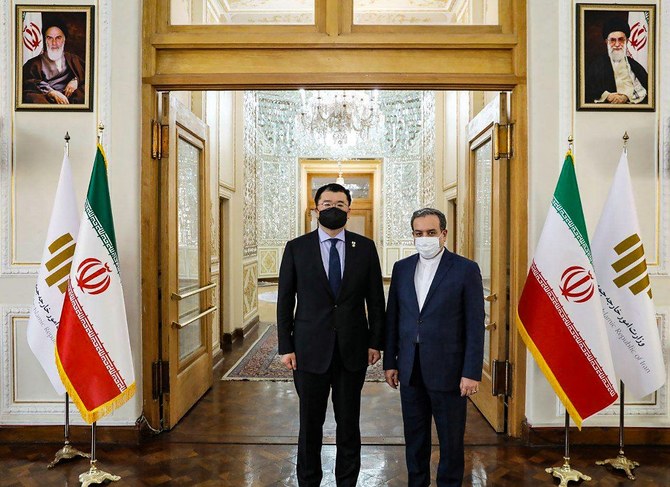DUBAI: South Korea’s vice foreign minister met with their Iranian counterpart to negotiate the release of the captured vessel and its crew, US-funded broadcaster Radio Farda reported.
Choi Jong-kun met with Abbas Araqchi to discuss the South Korean-flaged MT Hankuk Chemi seized by the Islamic Revolutionary Guards Corps (IRGC) on Jan. 4 as it was in the area of the Strait of Hormuz, the report added.
Iran said the IRGC seized the ship because it was leaking oil in violation of environmental laws.
“Seoul shouldn’t politicize the issue and rather wait until the factual investigation of the case by the Iranian judiciary is complete,” Araqchi was quoted as saying.
South Korea used to be a major buyer of Iranian oil until US ended their sanctions waiver on imports of Iranian oil in 2019. Around $7 billion of Iran’s funds are now frozen in two South Korean banks.
“For two-and-a-half years, our accounts have been frozen because of US sanctions and during this time South Korea has allowed itself to be bossed around by the United States," Araqchi added.
The US reimposed sanctions on Iran in 2018 after President Donald Trump withdrew from the 2015 nuclear deal.
“I’m a little relieved to know that the crew is safe, but the situation is serious,” Choi Jong-kun said.
According to South Korean Yonhap News Agency, Iran wants to free the money to purchase medical supplies and COVID-19 vaccines.


Negotiations continue between South Korea and Iran over release of tanker
Short Url
https://arab.news/8xbnr
Negotiations continue between South Korea and Iran over release of tanker

- Iran said the IRGC seized the ship because it was leaking oil in violation of environmental laws
- South Korea used to be a major buyer of Iranian oil until US ended their sanctions waiver on imports of Iranian oil in 2019
Lebanon says France to host conference to support army

- Lebanon said Wednesday that a conference in support of the country’s army as it seeks to disarm militant group Hezbollah would take place in Paris on March 5
BEIRUT: Lebanon said Wednesday that a conference in support of the country’s army as it seeks to disarm militant group Hezbollah would take place in Paris on March 5.
The announcement follows recent promises of support to the military, which lacks funds, equipment and technical expertise.
Presidency spokeswoman Najat Charafeddine said President Joseph Aoun met French envoy Jean-Yves Le Drian, Saudi envoy Yazid bin Farhan and ambassadors including from the US, Egypt and Qatar, discussing preparations for “a conference to support the Lebanese army and internal security forces.”
“It was decided to hold the conference in Paris on March 5, to be opened by French President Emmanuel Macron,” she said at the presidential palace.
Under US pressure and fearing expanded Israeli strikes, Lebanon has committed to disarming the Iran-backed Hezbollah, which was badly weakened in more than a year of hostilities with Israel that largely ended in late 2024.
Last week, Lebanon’s army said it had completed the first phase of its plan to disarm the group, covering the area south of the Litani river, around 30 kilometers (20 miles) from the Israeli border.
A plan for the disarmament north of the Litani is to be presented to cabinet next month.
Israel, which accuses Hezbollah or rearming, has criticized the army’s progress as insufficient, while Hezbollah has rejected calls to surrender its weapons.
Lebanon’s army has dismantled tunnels and other military infrastructure belonging to Hezbollah near the Israeli border in recent months, seizing weapons and ammunition, despite its limited capacities.
Despite the ceasefire, Israel has kept up regular strikes on Lebanon, usually saying it is targeting Hezbollah, and has maintained troops in five south Lebanon areas it deems strategic.
Last month, talks with international envoys in Paris touched on the Lebanese army’s needs, while its chief agreed to document its progress in disarming Hezbollah.
The announcement follows recent promises of support to the military, which lacks funds, equipment and technical expertise.
Presidency spokeswoman Najat Charafeddine said President Joseph Aoun met French envoy Jean-Yves Le Drian, Saudi envoy Yazid bin Farhan and ambassadors including from the US, Egypt and Qatar, discussing preparations for “a conference to support the Lebanese army and internal security forces.”
“It was decided to hold the conference in Paris on March 5, to be opened by French President Emmanuel Macron,” she said at the presidential palace.
Under US pressure and fearing expanded Israeli strikes, Lebanon has committed to disarming the Iran-backed Hezbollah, which was badly weakened in more than a year of hostilities with Israel that largely ended in late 2024.
Last week, Lebanon’s army said it had completed the first phase of its plan to disarm the group, covering the area south of the Litani river, around 30 kilometers (20 miles) from the Israeli border.
A plan for the disarmament north of the Litani is to be presented to cabinet next month.
Israel, which accuses Hezbollah or rearming, has criticized the army’s progress as insufficient, while Hezbollah has rejected calls to surrender its weapons.
Lebanon’s army has dismantled tunnels and other military infrastructure belonging to Hezbollah near the Israeli border in recent months, seizing weapons and ammunition, despite its limited capacities.
Despite the ceasefire, Israel has kept up regular strikes on Lebanon, usually saying it is targeting Hezbollah, and has maintained troops in five south Lebanon areas it deems strategic.
Last month, talks with international envoys in Paris touched on the Lebanese army’s needs, while its chief agreed to document its progress in disarming Hezbollah.
© 2026 SAUDI RESEARCH & PUBLISHING COMPANY, All Rights Reserved And subject to Terms of Use Agreement.












